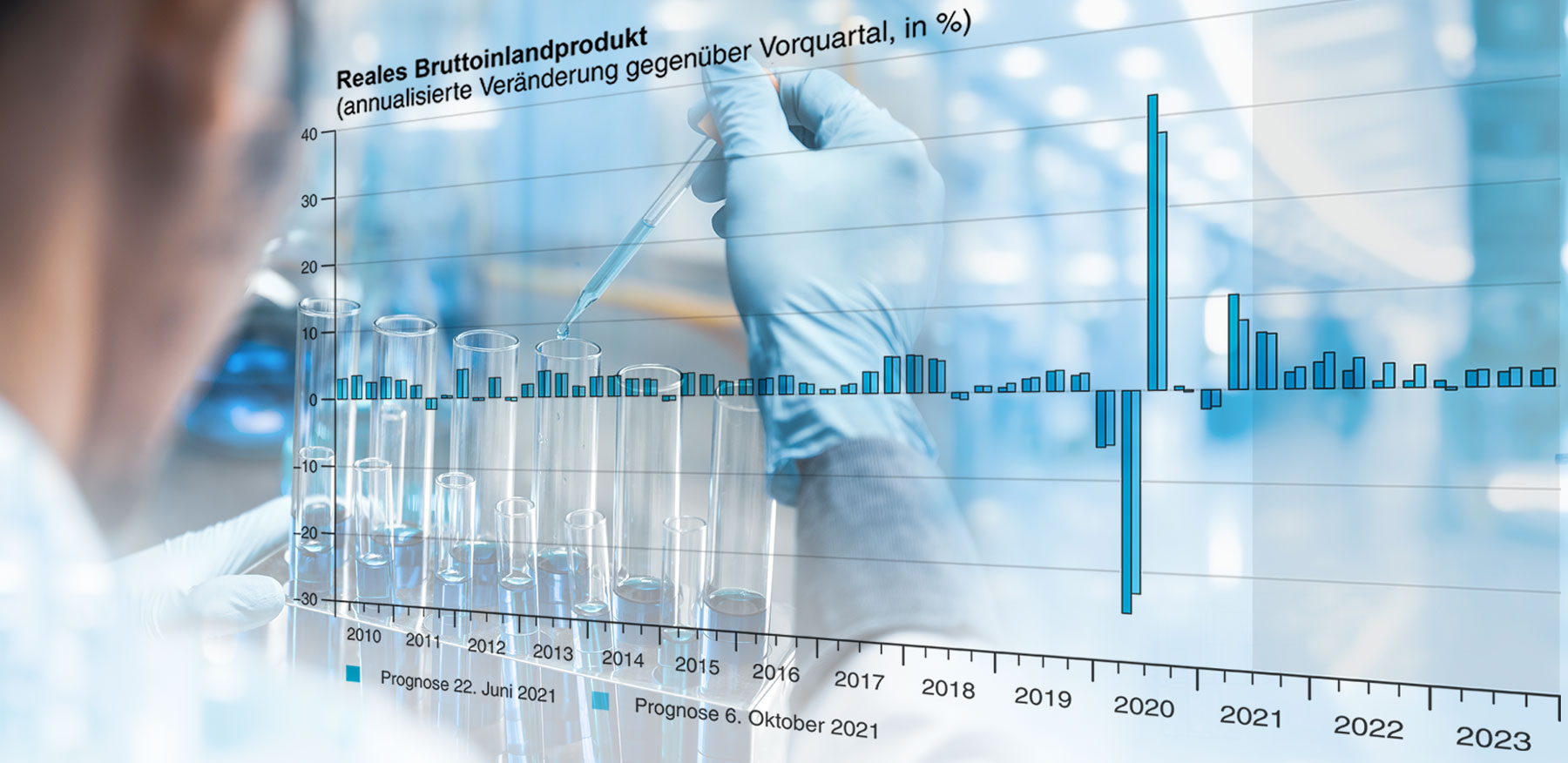KOF Economic Forecast: economic recovery continues; risks are becoming more diverse
The Swiss economy is performing well, but its rate of growth will have returned to normal by the end of 2023. Gross domestic product (GDP) will increase by 3.2 per cent in 2021 and by 3.6 per cent in 2022. Output is likely to have returned to its pre-crisis growth path by 2023.

Some of the economic recovery will be delayed until 2022
The economic outlook for 2021 and 2022 has not changed significantly compared with the forecast that KOF issued in June. However, the supply bottlenecks throughout the global economy and the evolution of the pandemic in Switzerland make the forecast for the current year slightly more cautious. This means that some of the recovery will be delayed until 2022, for which the latest forecast represents a modest upward revision. Adjusted for revenue received from major international sporting events, GDP is forecast to grow at a rate of 3.0 per cent this year, 3.4 per cent in 2022 and 1.8 per cent in 2023.
Supply-chain bottlenecks are acting as a drag on the international economy
International economy activity has managed to decouple further from the evolution of the pandemic. Global output weighted according to Switzerland’s share of exports has almost returned to its pre-crisis levels. However, growth rates in the international goods trade are now likely to return to normal because catch-up effects in the categories of goods hit particularly hard by the pandemic are largely over. Nonetheless, KOF sees further catch-up potential for the services sector in many regions of the world. A further factor is that some of the value chains disrupted by the pandemic are not yet operating as efficiently as they did before COVID-19, which is causing supply-chain bottlenecks. This is triggering production constraints and price rises, which will dampen the economic recovery until well into this winter. KOF expects that these bottlenecks will start to disappear in the first quarter of 2022 and will no longer seriously constrain output.
Pharmaceutical sector is driving Swiss exports
Having collapsed in the spring of 2020, the Swiss economy is on a bumpy and, in some cases, robust path to recovery. The correlation between the officially recorded infection rates and the constraints on economic activity has declined in Switzerland as well owing to the vaccination campaign. The key drivers of this recovery have been, on the demand side, pent-up consumer spending and, on the supply side, the reopening of businesses in the hospitality and personal services sectors. The recovery in industry has been relatively weak, especially in the production lines affected by international supply-chain problems – with the exception of the pharmaceutical sector. Pharmaceutical exports remain a key pillar of growth: they have been rising sharply for years both in absolute terms and as a share of Switzerland’s exports of goods.
KOF expects labour market to improve
The labour market appears to be recovering well from the pandemic. The summer half-year went well in terms of the numbers of registered unemployed, short-time working, and the employment statistics published by the Swiss Federal Statistical Office. However, the situation looks less encouraging if we look at the recently published unemployment figures as defined by the International Labour Organization (ILO) and the employment statistics. Nonetheless, KOF continues to forecast that the situation in the labour market will improve considerably in the second half of 2021 and in the coming winter half-year. Short-time working should continue to decline, the unemployment rate is likely to fall significantly and employment is expected to rise sharply as labour-intensive service sectors benefit from the lifting of restrictions. Workers, however, are likely to be disappointed by the level of wage growth because, after allowing for inflation, this delivers hardly any purchasing-power gains in real terms.
Inflationary pressures only temporary
Switzerland’s inflation has accelerated in recent months. However, it is more the case that prices are merely returning to normal from their low in the pandemic year of 2020. The key drivers here are the prices of air travel, package holidays and hotel accommodation, which had plummeted as a result of the pandemic. The same applies to energy prices, which are one of the main factors contributing to the general rise in prices. KOF therefore believes that current inflationary pressures are likely to be temporary. Underutilised production capacities and minimal nominal wage growth will, on the whole, continue to keep inflation low. Nonetheless, KOF’s inflation forecast is very slightly higher than its forecast in June owing to higher rents and the prices of goods from abroad. KOF is predicting average inflation of 0.5 per cent this year, 0.6 per cent next year and 0.4 per cent in 2023.
Forecasting risks no longer solely dominated by the pandemic
Forecasting risks are no longer dominated by the ongoing pandemic-related uncertainty and are now also caused by the economy itself. The main contributing factors to highlight here are the worldwide transportation and production bottlenecks, the inflationary risks associated with these bottlenecks and, in particular, with the sharp rise in energy prices, developments in the Chinese real-estate market and warnings that the Swiss property market could overheat.
Contact Swiss economy
KOF FB Konjunktur
Leonhardstrasse 21
8092
Zürich
Switzerland
Contact International economy
KOF Konjunkturforschungsstelle
Leonhardstrasse 21
8092
Zürich
Switzerland
